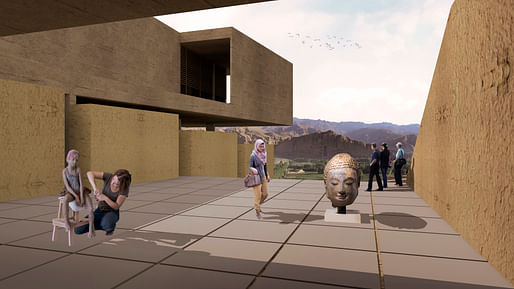

BAMIYAN CULTURAL CENTRE
A building, a mountain, a place to stay...
The building is located on top of a mountain in the Bamiyan Valley, Afghanistan. The building emerges from the ground and shows an affinity with the mountain. The building evokes the caves in the Buddha Cliff and also has a relationship with all the buildings around it, mostly made of clay, wood and stone. These visual similarities point a new form of interpreting the past, a culture, a context and a new future. The structure has being proposal to conserve Bamiyan and Afghan culture and help it to evolve to face our times but preserving their roots.
The building provides many open spaces of different characteristics in which visitors can engage in traditional activities (ceremonies), festivities, games, cultural events and many others. The building itself allows some programs can run independently giving greater flexibility of use and schedules.
The Mountain
The mountain contributes to the landscape heritage of Bamiyan Valley; it is a natural context where the building cares about to maintaining the profile of the mountain, adhering to it. In addition, the proposal seeks to exploit the magnificent view of the Budha Cliff and thus appropriating visually of it.
The Building
The project is developed in a volume that is located in the middle of two platforms, turning it in the connection or nexus between these. The building rises in the upper platform that descends and opens to the natural area of the lower platform, allowing users to ascend or descend through the complex.
In form terms, the building is formed by two volumes which are connected each other by the reception hall and the vertical circulations. The building has north orientation that coincides with views of the Budha Cliff. For that reason, both volumes open all their views to the green areas of the Bamiyan valley which has as a background the Budha Cliff. As a special characteristic, both volumes close their openings to the urban area, showing a closed volume which is related to the characteristics of the local architecture.
To take advantage of sunlight, the building has wooden skylights and vertical wooden blinds in vertical circulations and openings to provide natural lighting inside. As other form to introduce light to the interior spaces there are skylights on concrete roofs to provide indirect lighting especially for spaces that are not allowed to receive direct light.
The building is designed in two floors, developing a compact construction to reduce ecological footprint such that the areas of foundation are minimal. The building structure is reinforced concrete and the coating consists of combining concrete blocks and clay bricks. The clay bricks aside from giving a traditional appearance serve as collectors of heat, heat that is transferred in winter to the interior spaces. Also, exhibition areas have been covered by vaults in both directions to dispense with vertical supports and cover more useful area.
Spatial organization.
The project has divided into two floors, the first one located in the upper platform of the complex. The second one is semi-buried 4 meters for below the first one but not reach the lower platform of the complex which is located 6 meters below.
On the entrance floor are located the performance hall, the reception, the research program and the exhibition spaces. Also are located open spaces as: access, parking area, area for the installation of photovoltaic panels, areas of expansion for the exhibition zone and designated areas for traditional ceremonies.
In the lower floor are located the workshop studio program, the classrooms, administration, conference room and mechanical, electrical and plumbing installations. It has also earmarked a large green expansion for outdoor activities.
Sustainability
As a necessity for the lack of electricity have been allocated spaces for the installation of photovoltaic panels to generate electricity for the building facilities and to provide power to motors and pumps that allow raise water from Foladi river that could be treated and used in building facilities.
Because the irrigation of green areas has a high energy consumption in water terms, and rainwater is not a supply which is available and river water could not provide the large amount of water for irrigation, the proposal expected generate two different platforms, the first one with grass and the other one without it, these different characteristics of the open spaces will generate many uses and activities in the complex.
Status: Competition Entry